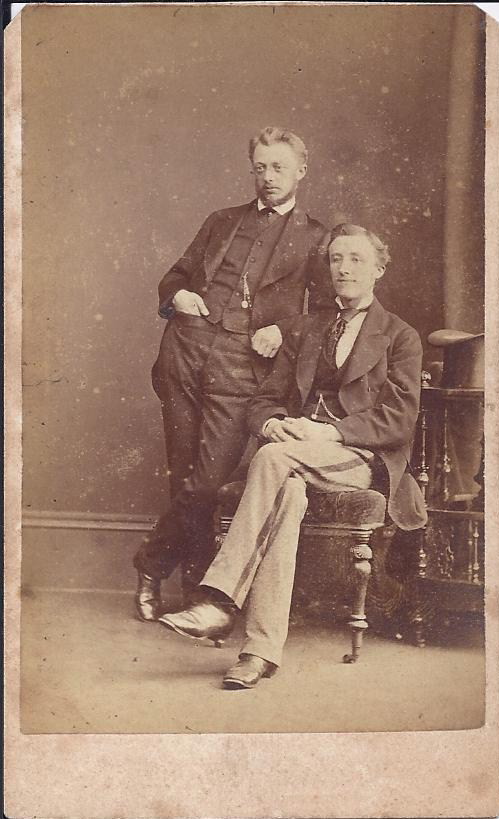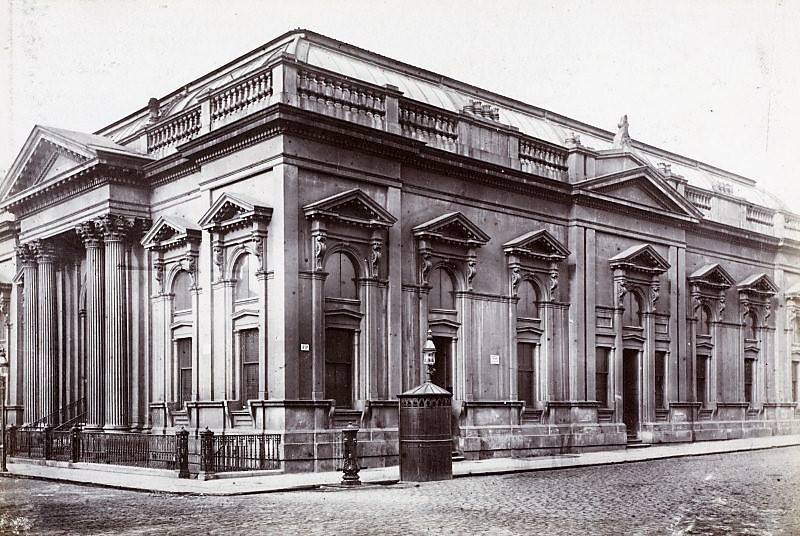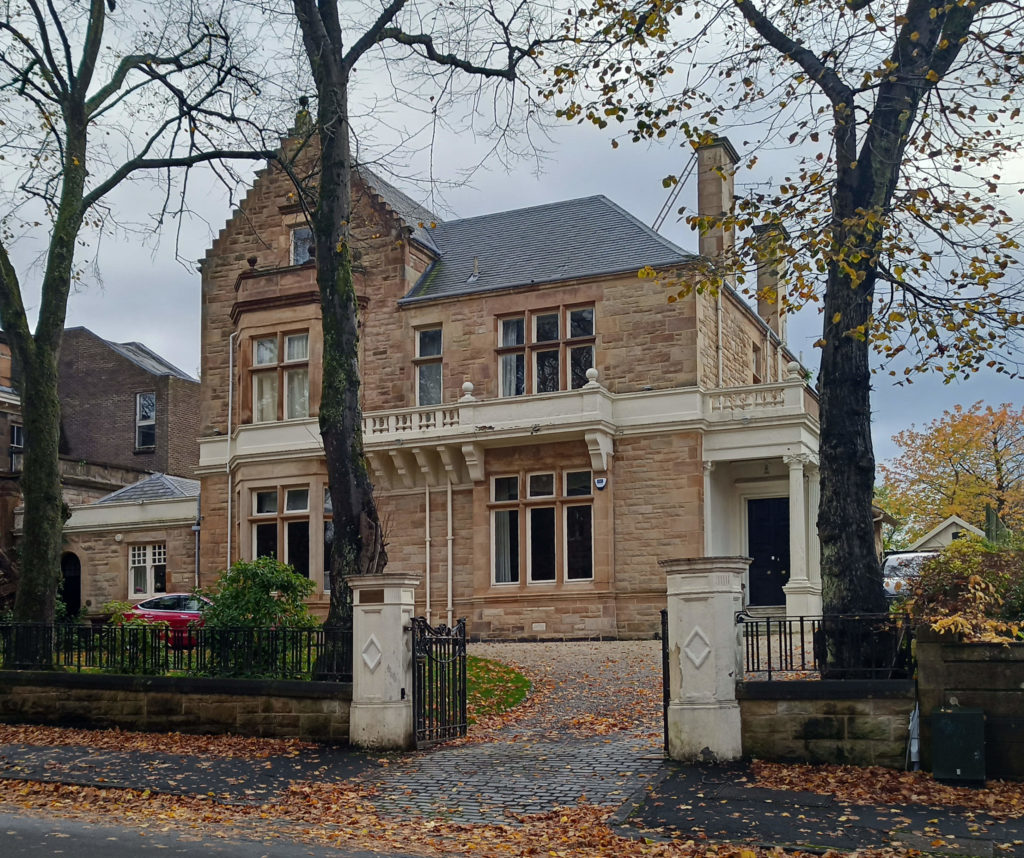When investigating the Frazer family’s 85-year occupation of 4 Moray Place, I forgot a minor detail — their early 1870s lodger, one BH Remmers.
Who was he? Turns out he was the most interesting character of the lot!
BH Remmers
Bernhard Heinrich Remmers was born in June 1843 at Hohenkirchen, in the Grand Duchy of Oldenburg (now northern Germany).
He first appeared in Glasgow in 1870, in his late twenties. He was living at Struan Terrace on Victoria Road, and working for Neuffert & Carr, corn factors, an Edinburgh firm with offices on Hope Street. He appears to have travelled back and forth between the UK and Europe, appearing in print in 1872 when co-signing a letter to the papers complaining about the terrible state of the Belgian cross-channel paddle steamers, and in particular his crossing to England on the Comtesse de Flandre .
He returned to Prussia soon after, and married Bertha Berneaud in July 1872 in Stettin (now Szczecin, Poland). A year later they were back in Glasgow, and living with the Frazers in Moray Place, when Bertha gave birth to the first of their four children. Their second was born in Strathbungo the following year.

Bernhard Remmers, standing, with unknown colleague, Glasgow 1880. Credit: Donna Remmers, Ancestry.com
He continued to trade in corn for Remmers & Meldrum, but also Remmers & Menzies (with fellow Strathbungo resident George Menzies, who lived at 8 Regent Park Terrace on Pollokshaws Road), and his own firm BH Remmers & Co. The firms’ offices were all in Waterloo or Hope Street, convenient for the Corn Exchange which sat on the corner of the two streets, but now sadly demolished .

The original Corn Exchange at Waterloo and Hope Streets. Credit: Thomas Annan
I can’t believe it’s not butter!
In 1875 Remmers hit headlines all over Britain, with many titles reproducing an investigation that first appeared in The Glasgow News of 26 November. It concerned a trade circular that came to the newspaper’s attention, issued by BH Remmers & Co. He claimed to improve and repack butter, quoting references from apparently satisfied customers in Edinburgh and Glasgow.

In practice Remmers was offering to take rancid, contaminated or mouldy butter (often known as “grease-butter” because its only remaining use was as a cheap lubricant), and clean it up so it could be passed off as new butter. Adulteration of food was common in Victorian times and indeed Parliament had recently passed an Act to prevent it, but butter was not covered by the Act.
The alarmed but intrepid journalists at the News got to work. They sent two under-cover “gentlemen” to Remmers, and were told indeed he could turn grease-butter into finest tub butter, was already producing 35 cwt (1800kg) daily from his factory in Leith (at JF Meiners, 1 James Place), and had opened new premises in Port Dundas for this purpose.
So the journalists obtained a firkin of rancid grease-butter, and just for good measure a common candle, wick removed, and a quantity of Russian tallow (beef fat), and even passed the tallow through one of their printing presses to get some metal oxide contamination into it. They then combined all the ingredients by melting.
They took their samples to be tested in the city laboratory. The butter as bought was described as “in … the last stage of rottenness. It has a disgusting odour, is covered with green mould, and is maggoty. I have not the slightest hesitation in saying that it is quite unfit for human food.” It was said to resemble a ripe Stilton. And that was before they had added the candle and tallow!
They took it to Remmers for processing. He noted it was “very bad” but promised to do what he could. A few days later he returned 50 lbs of butter, and this was reanalysed. It was noted to be remarkably transformed with a “very fair” result. But for the metal contamination seen under a microscope, “it would hardly have been possible for us to have identified the sample, so remarkable was the change in the whole composition.”
The News concluded merchants with low morals could obtain putrid butter cheaply, convert it and make a tidy profit selling it at the market price, and there was nothing to stop it reaching any town or village in the United Kingdom undetected. They never actually described how it tasted, although they did comment that the samples, and the end product, were available in their office for inspection, should any readers wish to do so .
Moving on
By 1876 Remmers had moved to Victoria Place, Shawlands but his firm was still describing itself as repackers of butter. After that episode he branched out into other fields of business, still mostly food related.
In 1877 he was advertising as agent for Bauer’s patent auto-polygraph, some form of early photocopier, while in 1878 he was selling filter-presses made by ALG Dehne in Germany, for separating liquids from solids .

Advert for Bauer’s Auto-Polygraph. Greenock Herald 7 Apr 1877. Credit: BNA
A paper trail
In 1879 he was involved in a fraud case, as reported by the Glasgow Herald in November.
At that time Remmers was sole partner in his firm. He was sued by a London paper merchant, August Nordberg & Co, for £196 as a result of actions by a third party, James Christie, a produce broker. Christie had previously purchased paper from Nordberg and sold it on, but had a poor track record of paying them, so instead it was agreed he would sell as an agent on their behalf, and they would then bill customers directly.
Christie asked Remmers to store for him a large order, 7 tons of paper, but he told Nordberg the paper had been ordered by Remmers. Christie then sold the paper to his customers. When Nordberg tried to bill Remmers he denied ever having ordered or received the paper, but it appears Remmers sent his denials to Christie, Nordberg’s agent, and Christie never sent them on.
The Sheriff found against Remmers for having made little effort to sort out the mess, and felt he should have realised Christie was not to be trusted and contacted Nordberg himself. The sheriff recommended Christie be prosecuted for fraud, but evidently also thought Remmers was either guilty of the “greatest possible negligence” in not realising what was going on, or perhaps was in on the act .
Pressing business
In the 1880s Remmers began manufacturing his own filter-presses and pumps for food processing, and took on a partner, engineer John Williamson. He moved to a newly built villa at 35 Newark Drive in Pollokshields, which he called Oldenburg after his birthplace.

“Oldenburg”, 35 Newark Drive (now “Auchenbrae”)
Over the next few years Remmers and Williamson applied for various patents such as
- Apparatus for Drying Organic Substances, &c. The apparatus comprises a series of endless carrying webs or bands fitted over each other within a drying house or chamber, and mounted either on chains or wire ropes at each side passing over driving wheels, led direct by driving and supporting rollers .
- Improvements in the manufacture of starch, and apparatus employed therein .
- An improved process of filtering paraffin oils, and of refining the solid paraffin obtained therefrom .
- For improvements in filter presses
Remmers was also due to present a paper at the Society of Chemical Industry’s AGM in 1885 “On the use of Dialysis in manufacturing processes” .
Disappearance
Things were not going as well as they seemed, however. On 13 May 1886 Remmers entered the St Vincent Street branch of the Union Bank and cashed a cheque for £600 from a firm of London sugar brokers. Staff were suspicious of the cheque, and on making enquiries discovered it was a forgery and alerted the authorities. He was not at work, having left for home in the afternoon. The police called at his villa in Pollokshields, but he wasn’t there either. A witness thought they had spotted him in Pollokshields that evening, but he was never seen again. The rumour was that he had left for America. Although they are never mentioned, I presume his family fled with him .

Serious Charge against a Glasgow Engineer. Edinburgh Evening News 17 May 1886. Credit: BNA
BH Remmers & Co promptly entered bankruptcy on 29th May, and poor John Williamson was left to carry the can. On 18 June he was examined by the Sheriff and explained how he had been a partner for some three years dealing with the engineering side of their machine manufacturing business, while Remmers dealt with the finances. They had assets of £12,000 and liabilities of only £8,000, so he believed, and he was unable to explain what had happened. The Sheriff issued a warrant for Remmers’ arrest, but he had already fled .
Re-emergence
According to Ancestry.com, one Bernhard Remmers arrived in New York on 5 August 1886, and later became a US citizen. He lived in New York, Philadelphia and Chicago, and died in Santa Barbara in 1927 aged 83. What he got up to in the US remains to be discovered.
Still inventing
Thanks to Derek (see comments), who alerted me to his US patents. He was awarded a patent (and a US passport) in 1896 when he was resident in Brooklyn, for a further modification to filter-presses. In 1918, now resident in Philadelphia, he won a patent in conjunction with the Armour Grain Co of Chicago for long-life dried sheets of potato – the description reads like a precursor of Smash and Pringles! The full patent applications are available on line .

Drawing from Remmer’s signed US patent application for filter-presses, 1896. Source: Google Patents
Here’s hoping he was a just victim of circumstance, who fulfilled his dreams in the Land of Opportunity.
Additions and corrections are welcome.
References
{3557955:TVLHKRHY};{3557955:U4RBBVMC};{3557955:AIM4EBFV},{3557955:57M4NIVP};{3557955:H3CSACNI};{3557955:ITS5ZZ7M};{3557955:HU2S6YF3};{3557955:WVVXXBQC};{3557955:WVVXXBQC};{3557955:4DKFC5X2};{3557955:WVVXXBQC};{3557955:KGAA8ZI7};{3557955:Z45AKSAW};{3557955:7UH8ZSCZ},{3557955:3UY5XW86}
vancouver
asc
0
3744
%7B%22status%22%3A%22success%22%2C%22updateneeded%22%3Afalse%2C%22instance%22%3A%22zotpress-b57b142b0fb57f4d0f9e702a143ee313%22%2C%22meta%22%3A%7B%22request_last%22%3A0%2C%22request_next%22%3A0%2C%22used_cache%22%3Atrue%7D%2C%22data%22%3A%5B%7B%22key%22%3A%223UY5XW86%22%2C%22library%22%3A%7B%22id%22%3A3557955%7D%2C%22meta%22%3A%7B%22creatorSummary%22%3A%22Remmers%22%2C%22parsedDate%22%3A%221918-03-05%22%2C%22numChildren%22%3A1%7D%2C%22bib%22%3A%22%3Cdiv%20class%3D%5C%22csl-bib-body%5C%22%20style%3D%5C%22line-height%3A%201.35%3B%20%5C%22%3E%5Cn%20%20%3Cdiv%20class%3D%5C%22csl-entry%5C%22%20style%3D%5C%22clear%3A%20left%3B%20%5C%22%3E%5Cn%20%20%20%20%3Cdiv%20class%3D%5C%22csl-left-margin%5C%22%20style%3D%5C%22float%3A%20left%3B%20padding-right%3A%200.5em%3B%20text-align%3A%20right%3B%20width%3A%201em%3B%5C%22%3E1.%3C%5C%2Fdiv%3E%3Cdiv%20class%3D%5C%22csl-right-inline%5C%22%20style%3D%5C%22margin%3A%200%20.4em%200%201.5em%3B%5C%22%3ERemmers%20B.%20United%20States%20Patent%20Office%20-%20Method%20of%20preparing%20precooked%20food%20products.%201918%20Mar%205%20%5Bcited%202022%20Oct%2024%5D%3B2.%20Available%20from%3A%20%3Ca%20href%3D%27https%3A%5C%2F%5C%2Fpatentimages.storage.googleapis.com%5C%2Fda%5C%2Fe8%5C%2F93%5C%2F081741dd257755%5C%2FUS1258047.pdf%27%3Ehttps%3A%5C%2F%5C%2Fpatentimages.storage.googleapis.com%5C%2Fda%5C%2Fe8%5C%2F93%5C%2F081741dd257755%5C%2FUS1258047.pdf%3C%5C%2Fa%3E%3C%5C%2Fdiv%3E%5Cn%20%20%3C%5C%2Fdiv%3E%5Cn%3C%5C%2Fdiv%3E%22%2C%22data%22%3A%7B%22itemType%22%3A%22journalArticle%22%2C%22title%22%3A%22United%20States%20Patent%20Office%20-%20Method%20of%20preparing%20precooked%20food%20products%22%2C%22creators%22%3A%5B%7B%22creatorType%22%3A%22author%22%2C%22firstName%22%3A%22Bernhard%22%2C%22lastName%22%3A%22Remmers%22%7D%5D%2C%22abstractNote%22%3A%22%22%2C%22date%22%3A%225%20Mar%201918%22%2C%22language%22%3A%22en%22%2C%22DOI%22%3A%22%22%2C%22ISSN%22%3A%22%22%2C%22url%22%3A%22https%3A%5C%2F%5C%2Fpatentimages.storage.googleapis.com%5C%2Fda%5C%2Fe8%5C%2F93%5C%2F081741dd257755%5C%2FUS1258047.pdf%22%2C%22collections%22%3A%5B%22CAR6MXPM%22%5D%2C%22dateModified%22%3A%222022-10-24T22%3A30%3A50Z%22%7D%7D%2C%7B%22key%22%3A%227UH8ZSCZ%22%2C%22library%22%3A%7B%22id%22%3A3557955%7D%2C%22meta%22%3A%7B%22creatorSummary%22%3A%22Remmers%22%2C%22parsedDate%22%3A%221896-07-28%22%2C%22numChildren%22%3A1%7D%2C%22bib%22%3A%22%3Cdiv%20class%3D%5C%22csl-bib-body%5C%22%20style%3D%5C%22line-height%3A%201.35%3B%20%5C%22%3E%5Cn%20%20%3Cdiv%20class%3D%5C%22csl-entry%5C%22%20style%3D%5C%22clear%3A%20left%3B%20%5C%22%3E%5Cn%20%20%20%20%3Cdiv%20class%3D%5C%22csl-left-margin%5C%22%20style%3D%5C%22float%3A%20left%3B%20padding-right%3A%200.5em%3B%20text-align%3A%20right%3B%20width%3A%201em%3B%5C%22%3E1.%3C%5C%2Fdiv%3E%3Cdiv%20class%3D%5C%22csl-right-inline%5C%22%20style%3D%5C%22margin%3A%200%20.4em%200%201.5em%3B%5C%22%3ERemmers%20B.%20United%20States%20Patent%20Office%20-%20Filter-Press.%201896%20Jul%2028%20%5Bcited%202022%20Oct%2024%5D%3B%20Available%20from%3A%20%3Ca%20href%3D%27https%3A%5C%2F%5C%2Fpatentimages.storage.googleapis.com%5C%2F50%5C%2F17%5C%2F97%5C%2F82a09c16768e39%5C%2FUS564715.pdf%27%3Ehttps%3A%5C%2F%5C%2Fpatentimages.storage.googleapis.com%5C%2F50%5C%2F17%5C%2F97%5C%2F82a09c16768e39%5C%2FUS564715.pdf%3C%5C%2Fa%3E%3C%5C%2Fdiv%3E%5Cn%20%20%3C%5C%2Fdiv%3E%5Cn%3C%5C%2Fdiv%3E%22%2C%22data%22%3A%7B%22itemType%22%3A%22journalArticle%22%2C%22title%22%3A%22United%20States%20Patent%20Office%20-%20Filter-Press%22%2C%22creators%22%3A%5B%7B%22creatorType%22%3A%22author%22%2C%22firstName%22%3A%22Bernhard%22%2C%22lastName%22%3A%22Remmers%22%7D%5D%2C%22abstractNote%22%3A%22%22%2C%22date%22%3A%2228%20Jul%201896%22%2C%22language%22%3A%22%22%2C%22DOI%22%3A%22%22%2C%22ISSN%22%3A%22%22%2C%22url%22%3A%22https%3A%5C%2F%5C%2Fpatentimages.storage.googleapis.com%5C%2F50%5C%2F17%5C%2F97%5C%2F82a09c16768e39%5C%2FUS564715.pdf%22%2C%22collections%22%3A%5B%22CAR6MXPM%22%5D%2C%22dateModified%22%3A%222022-10-24T22%3A29%3A54Z%22%7D%7D%2C%7B%22key%22%3A%22WVVXXBQC%22%2C%22library%22%3A%7B%22id%22%3A3557955%7D%2C%22meta%22%3A%7B%22creatorSummary%22%3A%22Society%20of%20Chemical%20Industry%20%28Great%20Britain%29%22%2C%22parsedDate%22%3A%221882%22%2C%22numChildren%22%3A0%7D%2C%22bib%22%3A%22%3Cdiv%20class%3D%5C%22csl-bib-body%5C%22%20style%3D%5C%22line-height%3A%201.35%3B%20%5C%22%3E%5Cn%20%20%3Cdiv%20class%3D%5C%22csl-entry%5C%22%20style%3D%5C%22clear%3A%20left%3B%20%5C%22%3E%5Cn%20%20%20%20%3Cdiv%20class%3D%5C%22csl-left-margin%5C%22%20style%3D%5C%22float%3A%20left%3B%20padding-right%3A%200.5em%3B%20text-align%3A%20right%3B%20width%3A%201em%3B%5C%22%3E1.%3C%5C%2Fdiv%3E%3Cdiv%20class%3D%5C%22csl-right-inline%5C%22%20style%3D%5C%22margin%3A%200%20.4em%200%201.5em%3B%5C%22%3ESociety%20of%20Chemical%20Industry%20%28Great%20Britain%29.%20Journal%20of%20the%20Society%20of%20Chemical%20Industry%20%5BInternet%5D.%20London%20%5Betc.%5D%3B%201882%20%5Bcited%202022%20Oct%2019%5D.%20716%20p.%20Available%20from%3A%20%3Ca%20href%3D%27http%3A%5C%2F%5C%2Farchive.org%5C%2Fdetails%5C%2Fjournals03soci%27%3Ehttp%3A%5C%2F%5C%2Farchive.org%5C%2Fdetails%5C%2Fjournals03soci%3C%5C%2Fa%3E%3C%5C%2Fdiv%3E%5Cn%20%20%3C%5C%2Fdiv%3E%5Cn%3C%5C%2Fdiv%3E%22%2C%22data%22%3A%7B%22itemType%22%3A%22book%22%2C%22title%22%3A%22Journal%20of%20the%20Society%20of%20Chemical%20Industry%22%2C%22creators%22%3A%5B%7B%22creatorType%22%3A%22author%22%2C%22name%22%3A%22Society%20of%20Chemical%20Industry%20%28Great%20Britain%29%22%7D%2C%7B%22creatorType%22%3A%22contributor%22%2C%22name%22%3A%22Gerstein%20-%20University%20of%20Toronto%22%7D%5D%2C%22abstractNote%22%3A%22Issued%201918-46%20in%20sections%3A%20v.%2037-65%2C%20Transactions%20and%20communications%20%28varies%20slightly%29%3B%20v.%2037-41%2C%20Review%20%28called%20also%20v.%201-5%29%3B%20v.%2042-62%2C%20Chemistry%20and%20industry%20%28varies%20slightly%3B%20called%20also%20v.%201-21%3B%20later%20issued%20separately%29%3B%20v.%2037-44%2C%20Abstracts%20%28superseded%201926%20by%20British%20chemical%20abstracts%2C%20ser.%20B.%20later%20British%20chemical%20and%20physiological%20asbstracts%2C%20ser.%20B%29%3B%20Vol.%2050%20accompanied%20by%20a%20special%20jubilee%20number%20dated%20July%201931%3B%20Supersedes%20its%20Proceedings%3B%20Superseded%20by%20Journal%20of%20applied%20chemistry%3B%20Review%20section%20continued%20by%20Chemistry%20%26%20industry%2C%201923-%3B%2012%22%2C%22date%22%3A%221882%22%2C%22language%22%3A%22eng%22%2C%22ISBN%22%3A%22%22%2C%22url%22%3A%22http%3A%5C%2F%5C%2Farchive.org%5C%2Fdetails%5C%2Fjournals03soci%22%2C%22collections%22%3A%5B%22CAR6MXPM%22%5D%2C%22dateModified%22%3A%222022-10-19T16%3A54%3A33Z%22%7D%7D%2C%7B%22key%22%3A%22HU2S6YF3%22%2C%22library%22%3A%7B%22id%22%3A3557955%7D%2C%22meta%22%3A%7B%22parsedDate%22%3A%221882-11-24%22%2C%22numChildren%22%3A1%7D%2C%22bib%22%3A%22%3Cdiv%20class%3D%5C%22csl-bib-body%5C%22%20style%3D%5C%22line-height%3A%201.35%3B%20%5C%22%3E%5Cn%20%20%3Cdiv%20class%3D%5C%22csl-entry%5C%22%20style%3D%5C%22clear%3A%20left%3B%20%5C%22%3E%5Cn%20%20%20%20%3Cdiv%20class%3D%5C%22csl-left-margin%5C%22%20style%3D%5C%22float%3A%20left%3B%20padding-right%3A%200.5em%3B%20text-align%3A%20right%3B%20width%3A%201em%3B%5C%22%3E1.%3C%5C%2Fdiv%3E%3Cdiv%20class%3D%5C%22csl-right-inline%5C%22%20style%3D%5C%22margin%3A%200%20.4em%200%201.5em%3B%5C%22%3EThe%20Engineer.%201882%20Nov%2024%3B%20Available%20from%3A%20%3Ca%20href%3D%27https%3A%5C%2F%5C%2Frepozytorium.biblos.pk.edu.pl%5C%2Fredo%5C%2Fresources%5C%2F35723%5C%2Ffile%5C%2Fscans%5C%2FOCR_rezultaty%5C%2F300000015953_A_v1_200dpi_q60.pdf%27%3Ehttps%3A%5C%2F%5C%2Frepozytorium.biblos.pk.edu.pl%5C%2Fredo%5C%2Fresources%5C%2F35723%5C%2Ffile%5C%2Fscans%5C%2FOCR_rezultaty%5C%2F300000015953_A_v1_200dpi_q60.pdf%3C%5C%2Fa%3E%3C%5C%2Fdiv%3E%5Cn%20%20%3C%5C%2Fdiv%3E%5Cn%3C%5C%2Fdiv%3E%22%2C%22data%22%3A%7B%22itemType%22%3A%22journalArticle%22%2C%22title%22%3A%22The%20Engineer%22%2C%22creators%22%3A%5B%5D%2C%22abstractNote%22%3A%22%22%2C%22date%22%3A%2224%20Nov%201882%22%2C%22language%22%3A%22en%22%2C%22DOI%22%3A%22%22%2C%22ISSN%22%3A%22%22%2C%22url%22%3A%22https%3A%5C%2F%5C%2Frepozytorium.biblos.pk.edu.pl%5C%2Fredo%5C%2Fresources%5C%2F35723%5C%2Ffile%5C%2Fscans%5C%2FOCR_rezultaty%5C%2F300000015953_A_v1_200dpi_q60.pdf%22%2C%22collections%22%3A%5B%22CAR6MXPM%22%5D%2C%22dateModified%22%3A%222022-10-19T16%3A54%3A10Z%22%7D%7D%2C%7B%22key%22%3A%224DKFC5X2%22%2C%22library%22%3A%7B%22id%22%3A3557955%7D%2C%22meta%22%3A%7B%22parsedDate%22%3A%221885-11-01%22%2C%22numChildren%22%3A0%7D%2C%22bib%22%3A%22%3Cdiv%20class%3D%5C%22csl-bib-body%5C%22%20style%3D%5C%22line-height%3A%201.35%3B%20%5C%22%3E%5Cn%20%20%3Cdiv%20class%3D%5C%22csl-entry%5C%22%20style%3D%5C%22clear%3A%20left%3B%20%5C%22%3E%5Cn%20%20%20%20%3Cdiv%20class%3D%5C%22csl-left-margin%5C%22%20style%3D%5C%22float%3A%20left%3B%20padding-right%3A%200.5em%3B%20text-align%3A%20right%3B%20width%3A%201em%3B%5C%22%3E1.%3C%5C%2Fdiv%3E%3Cdiv%20class%3D%5C%22csl-right-inline%5C%22%20style%3D%5C%22margin%3A%200%20.4em%200%201.5em%3B%5C%22%3EPatents.%20Holmes%26%23x2019%3B%20Brewing%20Trade%20Gazette%20%5BInternet%5D.%201885%20Nov%201%3B%20Available%20from%3A%20%3Ca%20href%3D%27https%3A%5C%2F%5C%2Fwww.britishnewspaperarchive.co.uk%5C%2Fviewer%5C%2Fbl%5C%2F0002623%5C%2F18851101%5C%2F037%5C%2F0016%27%3Ehttps%3A%5C%2F%5C%2Fwww.britishnewspaperarchive.co.uk%5C%2Fviewer%5C%2Fbl%5C%2F0002623%5C%2F18851101%5C%2F037%5C%2F0016%3C%5C%2Fa%3E%3C%5C%2Fdiv%3E%5Cn%20%20%3C%5C%2Fdiv%3E%5Cn%3C%5C%2Fdiv%3E%22%2C%22data%22%3A%7B%22itemType%22%3A%22newspaperArticle%22%2C%22title%22%3A%22Patents%22%2C%22creators%22%3A%5B%5D%2C%22abstractNote%22%3A%22%22%2C%22date%22%3A%221%20Nov%201885%22%2C%22section%22%3A%22%22%2C%22language%22%3A%22%22%2C%22ISSN%22%3A%22%22%2C%22url%22%3A%22https%3A%5C%2F%5C%2Fwww.britishnewspaperarchive.co.uk%5C%2Fviewer%5C%2Fbl%5C%2F0002623%5C%2F18851101%5C%2F037%5C%2F0016%22%2C%22collections%22%3A%5B%22CAR6MXPM%22%5D%2C%22dateModified%22%3A%222022-10-19T16%3A41%3A40Z%22%7D%7D%2C%7B%22key%22%3A%22KGAA8ZI7%22%2C%22library%22%3A%7B%22id%22%3A3557955%7D%2C%22meta%22%3A%7B%22parsedDate%22%3A%221886-05-17%22%2C%22numChildren%22%3A0%7D%2C%22bib%22%3A%22%3Cdiv%20class%3D%5C%22csl-bib-body%5C%22%20style%3D%5C%22line-height%3A%201.35%3B%20%5C%22%3E%5Cn%20%20%3Cdiv%20class%3D%5C%22csl-entry%5C%22%20style%3D%5C%22clear%3A%20left%3B%20%5C%22%3E%5Cn%20%20%20%20%3Cdiv%20class%3D%5C%22csl-left-margin%5C%22%20style%3D%5C%22float%3A%20left%3B%20padding-right%3A%200.5em%3B%20text-align%3A%20right%3B%20width%3A%201em%3B%5C%22%3E1.%3C%5C%2Fdiv%3E%3Cdiv%20class%3D%5C%22csl-right-inline%5C%22%20style%3D%5C%22margin%3A%200%20.4em%200%201.5em%3B%5C%22%3ESerious%20Charge%20against%20a%20Glasgow%20Engineer.%20Edinburgh%20Evening%20News%20%5BInternet%5D.%201886%20May%2017%3B%20Available%20from%3A%20%3Ca%20href%3D%27https%3A%5C%2F%5C%2Fwww.britishnewspaperarchive.co.uk%5C%2Fviewer%5C%2Fbl%5C%2F0000452%5C%2F18860517%5C%2F008%5C%2F0002%27%3Ehttps%3A%5C%2F%5C%2Fwww.britishnewspaperarchive.co.uk%5C%2Fviewer%5C%2Fbl%5C%2F0000452%5C%2F18860517%5C%2F008%5C%2F0002%3C%5C%2Fa%3E%3C%5C%2Fdiv%3E%5Cn%20%20%3C%5C%2Fdiv%3E%5Cn%3C%5C%2Fdiv%3E%22%2C%22data%22%3A%7B%22itemType%22%3A%22newspaperArticle%22%2C%22title%22%3A%22Serious%20Charge%20against%20a%20Glasgow%20Engineer%22%2C%22creators%22%3A%5B%5D%2C%22abstractNote%22%3A%22%22%2C%22date%22%3A%2217%20May%201886%22%2C%22section%22%3A%22%22%2C%22language%22%3A%22%22%2C%22ISSN%22%3A%22%22%2C%22url%22%3A%22https%3A%5C%2F%5C%2Fwww.britishnewspaperarchive.co.uk%5C%2Fviewer%5C%2Fbl%5C%2F0000452%5C%2F18860517%5C%2F008%5C%2F0002%22%2C%22collections%22%3A%5B%22CAR6MXPM%22%5D%2C%22dateModified%22%3A%222022-10-19T16%3A40%3A58Z%22%7D%7D%2C%7B%22key%22%3A%22Z45AKSAW%22%2C%22library%22%3A%7B%22id%22%3A3557955%7D%2C%22meta%22%3A%7B%22parsedDate%22%3A%221886-06-19%22%2C%22numChildren%22%3A0%7D%2C%22bib%22%3A%22%3Cdiv%20class%3D%5C%22csl-bib-body%5C%22%20style%3D%5C%22line-height%3A%201.35%3B%20%5C%22%3E%5Cn%20%20%3Cdiv%20class%3D%5C%22csl-entry%5C%22%20style%3D%5C%22clear%3A%20left%3B%20%5C%22%3E%5Cn%20%20%20%20%3Cdiv%20class%3D%5C%22csl-left-margin%5C%22%20style%3D%5C%22float%3A%20left%3B%20padding-right%3A%200.5em%3B%20text-align%3A%20right%3B%20width%3A%201em%3B%5C%22%3E1.%3C%5C%2Fdiv%3E%3Cdiv%20class%3D%5C%22csl-right-inline%5C%22%20style%3D%5C%22margin%3A%200%20.4em%200%201.5em%3B%5C%22%3EAn%20Absconding%20Bankrupt.%20Edinburgh%20Evening%20News%20%5BInternet%5D.%201886%20Jun%2019%3B%20Available%20from%3A%20%3Ca%20href%3D%27https%3A%5C%2F%5C%2Fwww.britishnewspaperarchive.co.uk%5C%2Fviewer%5C%2Fbl%5C%2F0000452%5C%2F18860619%5C%2F048%5C%2F0004%27%3Ehttps%3A%5C%2F%5C%2Fwww.britishnewspaperarchive.co.uk%5C%2Fviewer%5C%2Fbl%5C%2F0000452%5C%2F18860619%5C%2F048%5C%2F0004%3C%5C%2Fa%3E%3C%5C%2Fdiv%3E%5Cn%20%20%3C%5C%2Fdiv%3E%5Cn%3C%5C%2Fdiv%3E%22%2C%22data%22%3A%7B%22itemType%22%3A%22newspaperArticle%22%2C%22title%22%3A%22An%20Absconding%20Bankrupt%22%2C%22creators%22%3A%5B%5D%2C%22abstractNote%22%3A%22%22%2C%22date%22%3A%2219%20Jun%201886%22%2C%22section%22%3A%22%22%2C%22language%22%3A%22%22%2C%22ISSN%22%3A%22%22%2C%22url%22%3A%22https%3A%5C%2F%5C%2Fwww.britishnewspaperarchive.co.uk%5C%2Fviewer%5C%2Fbl%5C%2F0000452%5C%2F18860619%5C%2F048%5C%2F0004%22%2C%22collections%22%3A%5B%22CAR6MXPM%22%5D%2C%22dateModified%22%3A%222022-10-19T16%3A20%3A25Z%22%7D%7D%2C%7B%22key%22%3A%2257M4NIVP%22%2C%22library%22%3A%7B%22id%22%3A3557955%7D%2C%22meta%22%3A%7B%22parsedDate%22%3A%221875-12-13%22%2C%22numChildren%22%3A0%7D%2C%22bib%22%3A%22%3Cdiv%20class%3D%5C%22csl-bib-body%5C%22%20style%3D%5C%22line-height%3A%201.35%3B%20%5C%22%3E%5Cn%20%20%3Cdiv%20class%3D%5C%22csl-entry%5C%22%20style%3D%5C%22clear%3A%20left%3B%20%5C%22%3E%5Cn%20%20%20%20%3Cdiv%20class%3D%5C%22csl-left-margin%5C%22%20style%3D%5C%22float%3A%20left%3B%20padding-right%3A%200.5em%3B%20text-align%3A%20right%3B%20width%3A%201em%3B%5C%22%3E1.%3C%5C%2Fdiv%3E%3Cdiv%20class%3D%5C%22csl-right-inline%5C%22%20style%3D%5C%22margin%3A%200%20.4em%200%201.5em%3B%5C%22%3EFood%20Adulteration.%20Staffordshire%20Sentinel%20%5BInternet%5D.%201875%20Dec%2013%3B%20Available%20from%3A%20%3Ca%20href%3D%27https%3A%5C%2F%5C%2Fwww.britishnewspaperarchive.co.uk%5C%2Fviewer%5C%2Fbl%5C%2F0000346%5C%2F18751213%5C%2F017%5C%2F0004%27%3Ehttps%3A%5C%2F%5C%2Fwww.britishnewspaperarchive.co.uk%5C%2Fviewer%5C%2Fbl%5C%2F0000346%5C%2F18751213%5C%2F017%5C%2F0004%3C%5C%2Fa%3E%3C%5C%2Fdiv%3E%5Cn%20%20%3C%5C%2Fdiv%3E%5Cn%3C%5C%2Fdiv%3E%22%2C%22data%22%3A%7B%22itemType%22%3A%22newspaperArticle%22%2C%22title%22%3A%22Food%20Adulteration%22%2C%22creators%22%3A%5B%5D%2C%22abstractNote%22%3A%22%22%2C%22date%22%3A%2213%20Dec%201875%22%2C%22section%22%3A%22%22%2C%22language%22%3A%22%22%2C%22ISSN%22%3A%22%22%2C%22url%22%3A%22https%3A%5C%2F%5C%2Fwww.britishnewspaperarchive.co.uk%5C%2Fviewer%5C%2Fbl%5C%2F0000346%5C%2F18751213%5C%2F017%5C%2F0004%22%2C%22collections%22%3A%5B%22CAR6MXPM%22%5D%2C%22dateModified%22%3A%222022-10-19T16%3A14%3A47Z%22%7D%7D%2C%7B%22key%22%3A%22AIM4EBFV%22%2C%22library%22%3A%7B%22id%22%3A3557955%7D%2C%22meta%22%3A%7B%22parsedDate%22%3A%221875-11-27%22%2C%22numChildren%22%3A0%7D%2C%22bib%22%3A%22%3Cdiv%20class%3D%5C%22csl-bib-body%5C%22%20style%3D%5C%22line-height%3A%201.35%3B%20%5C%22%3E%5Cn%20%20%3Cdiv%20class%3D%5C%22csl-entry%5C%22%20style%3D%5C%22clear%3A%20left%3B%20%5C%22%3E%5Cn%20%20%20%20%3Cdiv%20class%3D%5C%22csl-left-margin%5C%22%20style%3D%5C%22float%3A%20left%3B%20padding-right%3A%200.5em%3B%20text-align%3A%20right%3B%20width%3A%201em%3B%5C%22%3E1.%3C%5C%2Fdiv%3E%3Cdiv%20class%3D%5C%22csl-right-inline%5C%22%20style%3D%5C%22margin%3A%200%20.4em%200%201.5em%3B%5C%22%3EStartling%20Disclosures%20in%20the%20Butter%20Trade.%20Leith%20Burghs%20Pilot%20%5BInternet%5D.%201875%20Nov%2027%3B%20Available%20from%3A%20%3Ca%20href%3D%27https%3A%5C%2F%5C%2Fwww.britishnewspaperarchive.co.uk%5C%2Fviewer%5C%2Fbl%5C%2F0002716%5C%2F18751127%5C%2F026%5C%2F0002%27%3Ehttps%3A%5C%2F%5C%2Fwww.britishnewspaperarchive.co.uk%5C%2Fviewer%5C%2Fbl%5C%2F0002716%5C%2F18751127%5C%2F026%5C%2F0002%3C%5C%2Fa%3E%3C%5C%2Fdiv%3E%5Cn%20%20%3C%5C%2Fdiv%3E%5Cn%3C%5C%2Fdiv%3E%22%2C%22data%22%3A%7B%22itemType%22%3A%22newspaperArticle%22%2C%22title%22%3A%22Startling%20Disclosures%20in%20the%20Butter%20Trade%22%2C%22creators%22%3A%5B%5D%2C%22abstractNote%22%3A%22%22%2C%22date%22%3A%2227%20Nov%201875%22%2C%22section%22%3A%22%22%2C%22language%22%3A%22%22%2C%22ISSN%22%3A%22%22%2C%22url%22%3A%22https%3A%5C%2F%5C%2Fwww.britishnewspaperarchive.co.uk%5C%2Fviewer%5C%2Fbl%5C%2F0002716%5C%2F18751127%5C%2F026%5C%2F0002%22%2C%22collections%22%3A%5B%22CAR6MXPM%22%5D%2C%22dateModified%22%3A%222022-10-19T15%3A45%3A10Z%22%7D%7D%2C%7B%22key%22%3A%22H3CSACNI%22%2C%22library%22%3A%7B%22id%22%3A3557955%7D%2C%22meta%22%3A%7B%22parsedDate%22%3A%221877-04-07%22%2C%22numChildren%22%3A0%7D%2C%22bib%22%3A%22%3Cdiv%20class%3D%5C%22csl-bib-body%5C%22%20style%3D%5C%22line-height%3A%201.35%3B%20%5C%22%3E%5Cn%20%20%3Cdiv%20class%3D%5C%22csl-entry%5C%22%20style%3D%5C%22clear%3A%20left%3B%20%5C%22%3E%5Cn%20%20%20%20%3Cdiv%20class%3D%5C%22csl-left-margin%5C%22%20style%3D%5C%22float%3A%20left%3B%20padding-right%3A%200.5em%3B%20text-align%3A%20right%3B%20width%3A%201em%3B%5C%22%3E1.%3C%5C%2Fdiv%3E%3Cdiv%20class%3D%5C%22csl-right-inline%5C%22%20style%3D%5C%22margin%3A%200%20.4em%200%201.5em%3B%5C%22%3EBauer%26%23x2019%3Bs%20Patent%20Auto-Polygraph.%20Greenock%20Herald%20%5BInternet%5D.%201877%20Apr%207%3B%20Available%20from%3A%20%3Ca%20href%3D%27https%3A%5C%2F%5C%2Fwww.britishnewspaperarchive.co.uk%5C%2Fviewer%5C%2Fbl%5C%2F0003357%5C%2F18770407%5C%2F080%5C%2F0004%27%3Ehttps%3A%5C%2F%5C%2Fwww.britishnewspaperarchive.co.uk%5C%2Fviewer%5C%2Fbl%5C%2F0003357%5C%2F18770407%5C%2F080%5C%2F0004%3C%5C%2Fa%3E%3C%5C%2Fdiv%3E%5Cn%20%20%3C%5C%2Fdiv%3E%5Cn%3C%5C%2Fdiv%3E%22%2C%22data%22%3A%7B%22itemType%22%3A%22newspaperArticle%22%2C%22title%22%3A%22Bauer%27s%20Patent%20Auto-Polygraph%22%2C%22creators%22%3A%5B%5D%2C%22abstractNote%22%3A%22%22%2C%22date%22%3A%227%20April%201877%22%2C%22section%22%3A%22%22%2C%22language%22%3A%22%22%2C%22ISSN%22%3A%22%22%2C%22url%22%3A%22https%3A%5C%2F%5C%2Fwww.britishnewspaperarchive.co.uk%5C%2Fviewer%5C%2Fbl%5C%2F0003357%5C%2F18770407%5C%2F080%5C%2F0004%22%2C%22collections%22%3A%5B%22CAR6MXPM%22%5D%2C%22dateModified%22%3A%222022-10-19T15%3A42%3A23Z%22%7D%7D%2C%7B%22key%22%3A%22ITS5ZZ7M%22%2C%22library%22%3A%7B%22id%22%3A3557955%7D%2C%22meta%22%3A%7B%22parsedDate%22%3A%221879-11-13%22%2C%22numChildren%22%3A0%7D%2C%22bib%22%3A%22%3Cdiv%20class%3D%5C%22csl-bib-body%5C%22%20style%3D%5C%22line-height%3A%201.35%3B%20%5C%22%3E%5Cn%20%20%3Cdiv%20class%3D%5C%22csl-entry%5C%22%20style%3D%5C%22clear%3A%20left%3B%20%5C%22%3E%5Cn%20%20%20%20%3Cdiv%20class%3D%5C%22csl-left-margin%5C%22%20style%3D%5C%22float%3A%20left%3B%20padding-right%3A%200.5em%3B%20text-align%3A%20right%3B%20width%3A%201em%3B%5C%22%3E1.%3C%5C%2Fdiv%3E%3Cdiv%20class%3D%5C%22csl-right-inline%5C%22%20style%3D%5C%22margin%3A%200%20.4em%200%201.5em%3B%5C%22%3EImportant%20Decision%20in%20a%20Commercial%20Case.%20Glasgow%20Herald%20%5BInternet%5D.%201879%20Nov%2013%3B%20Available%20from%3A%20%3Ca%20href%3D%27https%3A%5C%2F%5C%2Fwww.britishnewspaperarchive.co.uk%5C%2Fviewer%5C%2Fbl%5C%2F0000060%5C%2F18791113%5C%2F047%5C%2F0007%27%3Ehttps%3A%5C%2F%5C%2Fwww.britishnewspaperarchive.co.uk%5C%2Fviewer%5C%2Fbl%5C%2F0000060%5C%2F18791113%5C%2F047%5C%2F0007%3C%5C%2Fa%3E%3C%5C%2Fdiv%3E%5Cn%20%20%3C%5C%2Fdiv%3E%5Cn%3C%5C%2Fdiv%3E%22%2C%22data%22%3A%7B%22itemType%22%3A%22newspaperArticle%22%2C%22title%22%3A%22Important%20Decision%20in%20a%20Commercial%20Case%22%2C%22creators%22%3A%5B%5D%2C%22abstractNote%22%3A%22%22%2C%22date%22%3A%2213%20Nov%201879%22%2C%22section%22%3A%22%22%2C%22language%22%3A%22%22%2C%22ISSN%22%3A%22%22%2C%22url%22%3A%22https%3A%5C%2F%5C%2Fwww.britishnewspaperarchive.co.uk%5C%2Fviewer%5C%2Fbl%5C%2F0000060%5C%2F18791113%5C%2F047%5C%2F0007%22%2C%22collections%22%3A%5B%22CAR6MXPM%22%5D%2C%22dateModified%22%3A%222022-10-19T15%3A40%3A29Z%22%7D%7D%2C%7B%22key%22%3A%22U4RBBVMC%22%2C%22library%22%3A%7B%22id%22%3A3557955%7D%2C%22meta%22%3A%7B%22numChildren%22%3A1%7D%2C%22bib%22%3A%22%3Cdiv%20class%3D%5C%22csl-bib-body%5C%22%20style%3D%5C%22line-height%3A%201.35%3B%20%5C%22%3E%5Cn%20%20%3Cdiv%20class%3D%5C%22csl-entry%5C%22%20style%3D%5C%22clear%3A%20left%3B%20%5C%22%3E%5Cn%20%20%20%20%3Cdiv%20class%3D%5C%22csl-left-margin%5C%22%20style%3D%5C%22float%3A%20left%3B%20padding-right%3A%200.5em%3B%20text-align%3A%20right%3B%20width%3A%201em%3B%5C%22%3E1.%3C%5C%2Fdiv%3E%3Cdiv%20class%3D%5C%22csl-right-inline%5C%22%20style%3D%5C%22margin%3A%200%20.4em%200%201.5em%3B%5C%22%3ELost%20Glasgow%20%5BInternet%5D.%20%5Bcited%202022%20Oct%2019%5D.%20Glasgow%26%23x2019%3Bs%20daily%20grind.%20Available%20from%3A%20%3Ca%20href%3D%27https%3A%5C%2F%5C%2Fwww.lostglasgow.scot%5C%2Fposts%5C%2Fglasgows-daily-grind-394%5C%2F%27%3Ehttps%3A%5C%2F%5C%2Fwww.lostglasgow.scot%5C%2Fposts%5C%2Fglasgows-daily-grind-394%5C%2F%3C%5C%2Fa%3E%3C%5C%2Fdiv%3E%5Cn%20%20%3C%5C%2Fdiv%3E%5Cn%3C%5C%2Fdiv%3E%22%2C%22data%22%3A%7B%22itemType%22%3A%22webpage%22%2C%22title%22%3A%22Glasgow%27s%20daily%20grind%22%2C%22creators%22%3A%5B%5D%2C%22abstractNote%22%3A%22Fair%20Exchange%20for%20the%20city%3F%22%2C%22date%22%3A%22%22%2C%22url%22%3A%22https%3A%5C%2F%5C%2Fwww.lostglasgow.scot%5C%2Fposts%5C%2Fglasgows-daily-grind-394%5C%2F%22%2C%22language%22%3A%22%22%2C%22collections%22%3A%5B%22CAR6MXPM%22%5D%2C%22dateModified%22%3A%222022-10-19T15%3A23%3A54Z%22%7D%7D%2C%7B%22key%22%3A%22TVLHKRHY%22%2C%22library%22%3A%7B%22id%22%3A3557955%7D%2C%22meta%22%3A%7B%22parsedDate%22%3A%221872-01-01%22%2C%22numChildren%22%3A0%7D%2C%22bib%22%3A%22%3Cdiv%20class%3D%5C%22csl-bib-body%5C%22%20style%3D%5C%22line-height%3A%201.35%3B%20%5C%22%3E%5Cn%20%20%3Cdiv%20class%3D%5C%22csl-entry%5C%22%20style%3D%5C%22clear%3A%20left%3B%20%5C%22%3E%5Cn%20%20%20%20%3Cdiv%20class%3D%5C%22csl-left-margin%5C%22%20style%3D%5C%22float%3A%20left%3B%20padding-right%3A%200.5em%3B%20text-align%3A%20right%3B%20width%3A%201em%3B%5C%22%3E1.%3C%5C%2Fdiv%3E%3Cdiv%20class%3D%5C%22csl-right-inline%5C%22%20style%3D%5C%22margin%3A%200%20.4em%200%201.5em%3B%5C%22%3EDangers%20of%20Travel.%20Evening%20Mail%20%5BInternet%5D.%201872%20Jan%201%3B%20Available%20from%3A%20%3Ca%20href%3D%27https%3A%5C%2F%5C%2Fwww.britishnewspaperarchive.co.uk%5C%2Fviewer%5C%2Fbl%5C%2F0003187%5C%2F18720101%5C%2F004%5C%2F0001%27%3Ehttps%3A%5C%2F%5C%2Fwww.britishnewspaperarchive.co.uk%5C%2Fviewer%5C%2Fbl%5C%2F0003187%5C%2F18720101%5C%2F004%5C%2F0001%3C%5C%2Fa%3E%3C%5C%2Fdiv%3E%5Cn%20%20%3C%5C%2Fdiv%3E%5Cn%3C%5C%2Fdiv%3E%22%2C%22data%22%3A%7B%22itemType%22%3A%22newspaperArticle%22%2C%22title%22%3A%22Dangers%20of%20Travel%22%2C%22creators%22%3A%5B%5D%2C%22abstractNote%22%3A%22%22%2C%22date%22%3A%221%20Jan%201872%22%2C%22section%22%3A%22%22%2C%22language%22%3A%22%22%2C%22ISSN%22%3A%22%22%2C%22url%22%3A%22https%3A%5C%2F%5C%2Fwww.britishnewspaperarchive.co.uk%5C%2Fviewer%5C%2Fbl%5C%2F0003187%5C%2F18720101%5C%2F004%5C%2F0001%22%2C%22collections%22%3A%5B%22CAR6MXPM%22%5D%2C%22dateModified%22%3A%222022-10-19T15%3A23%3A54Z%22%7D%7D%5D%7D
1.
Society of Chemical Industry (Great Britain). Journal of the Society of Chemical Industry [Internet]. London [etc.]; 1882 [cited 2022 Oct 19]. 716 p. Available from:
http://archive.org/details/journals03soci
Like this:
Like Loading...









October 22, 2022 at 2:51 pm
What a scoundrel! Great story, Andrew.
October 24, 2022 at 8:14 am
Behind all that Victorian respectability, there lurks a bit of scandal…who’d have thought it. A search pulled up a Bernhard Remmers in 1917, in Philadelphia, having a patent for a method of preparing pre-cooked food. Nothing about butter, tho’.